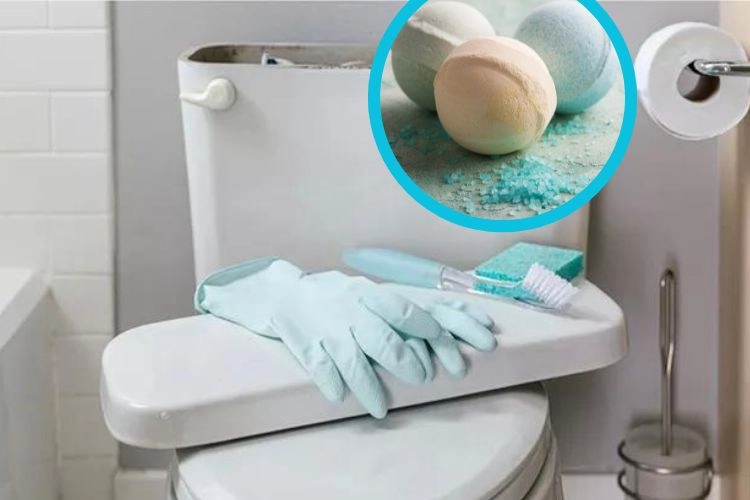When cleaning the toilet area, the cistern is often overlooked. Actually, however, it has to be disinfected regularly so that no bacteria or mold develop. If you clean your toilet cistern regularly, you can also prevent rust and limescale deposits.
Clean the toilet cistern: This home remedy disinfects and neutralizes odors
The toilet cistern must be cleaned at least once a month. Otherwise, mold can form and spread dangerous bacteria. Serratia marcescens are bacteria that multiply rapidly in the toilet. In hospitals, the pathogen triggers wound infections, skin inflammation and pneumonia. Mold can cause allergies and lime deposits can damage the parts in the cistern. Unfortunately, cleaning the toilet tank is a time-consuming and tedious job. With a homemade toilet bomb, you can get the inside of the toilet cistern clean without scrubbing and can even neutralize unpleasant odors.
Before cleaning the toilet tank, find the shut-off valve or faucet and turn off the water. Then detach the cover and remove or remove all moving parts in the cistern. Schedule cleaning during a period when people use the toilet less often – late at night, for example.
If there is mold, first disinfect the cistern with vinegar essence
In some cases, when the cistern has not been cleaned for a long time, additional disinfection is necessary. Otherwise, dirty water runs into the toilet bowl. How to tell if you should also disinfect the toilet cistern:
The flushing does not work or works poorly. The flushing water runs on for longer than normal. You notice an orange streak of water in the toilet cistern. You notice mold in the cistern.
A vinegar essence solution or lemon juice is well suited for disinfection. It is environmentally friendly, does not damage rubber seals and metal parts and reliably removes mold spores. Proceed as follows: Pour 100 ml vinegar essence and 400 ml water into a 1 liter plastic bottle. Shake the bottle to mix the two well and put some vinegar essence solution on a kitchen sponge. Then gently rub the solution into the walls, floor and caulking with the kitchen sponge. Fill the rest of the solution into the empty toilet tank and leave it on for about 40 to a maximum of 50 minutes. Then rinse them off.
DIY toilet bomb and air freshener in one
If there is no mold in the toilet tank, then you can regularly clean it with a homemade toilet bomb. To do this, simply mix the following ingredients together:
Ingredients:
50 ml citric acid 100 ml baking soda 1/2 teaspoon liquid soap or dish soap 12 drops essential oils such as lavender or tea tree oil
Accesories:
Glass bowl Silicone muffin cups Spoon Rubber gloves
Preparation:
Add the baking powder and citric acid to the bowl and mix. Add the essential oils and mix well. Slowly add the liquid soap to the baking powder mixture while stirring constantly. It should be moderately damp and easy to shape with your hands. Fill the muffin cases and let the bombs dry for about 12 to 14 hours. Then carefully remove them from the muffin cases and let them dry for another 2-3 days. Put the bombs in a jam jar with an airtight seal and store in a dry and dark place.
How to use the bombs correctly:
Place a bomb in the toilet tank (it should be full of water). If necessary, you can also give it a little extra scrubbing with a clean, long-handled brush. Then flush the toilet two or three times to remove any remains of the bomb. The essential oils will neutralize unpleasant odors over the next few days and flavor the dishwashing water.
These bath bombs clean and prevent limescale deposits. However, if the cistern is already calcified, then you have to add a cup of lemon juice to the flushing water once a month and let it sit for about an hour. Then rinse several times and you’re done. Pumice stone also helps against limescale – you can simply rub off the deposits with it. Pumice will not damage metal parts or rubber seals and is a very effective alternative to lemon juice and citric acid. Because both can attack metal parts and rubber seals if they are not diluted with water.
Cleaning the toilet cistern: the most important things summarized
Mold, limescale and bacteria can damage the cistern and pose a health risk. That is why everyone should clean the toilet cistern once or twice a month. Best with homemade toilet bombs, which have a short exposure time. You can also disinfect the rinsing water and neutralize unpleasant odours.
However, if you notice mold and limescale in the cistern, you should first clean it with a solution of citric acid and water.
